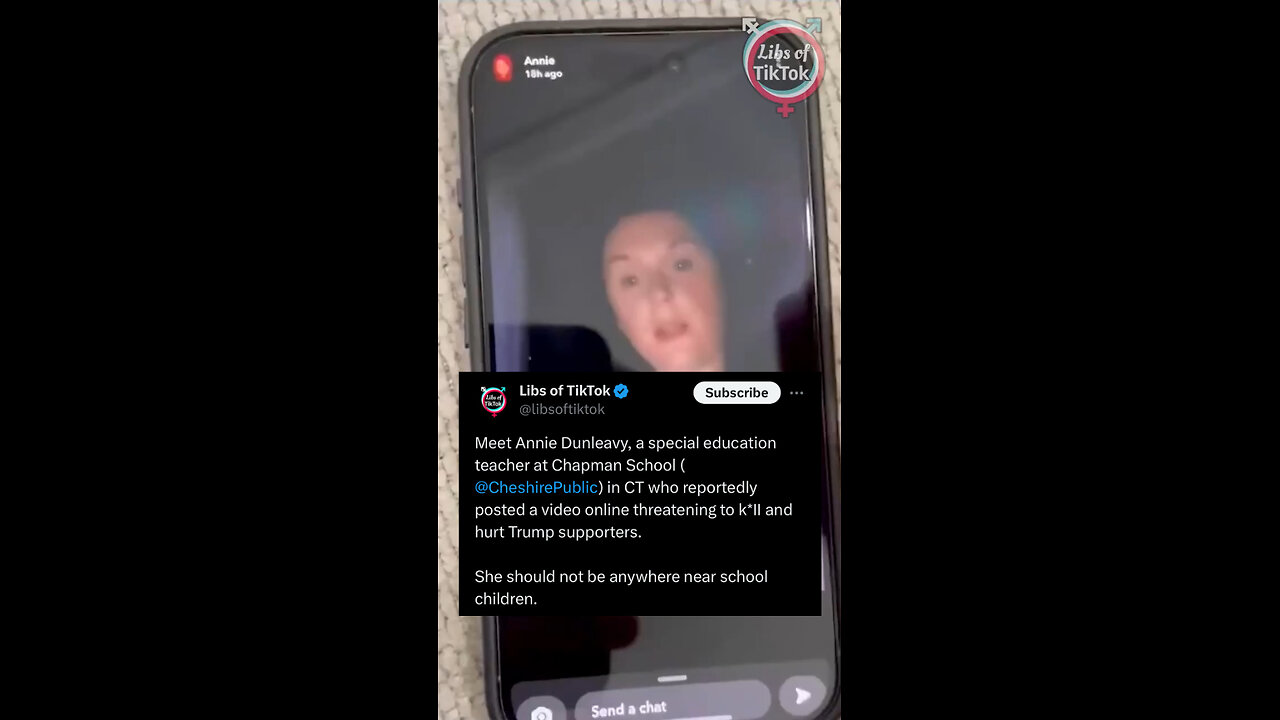Premium Only Content

Trump Derangement Syndrome: A Deep Dive into Polarization and Political Obsession
In the modern age of hyper-polarization, few figures have sparked as much division and controversy as Donald J. Trump. The phenomenon of Trump Derangement Syndrome (TDS)—a term coined to describe an irrational and often obsessive hatred of Trump—has become a cultural and psychological marker of our time. While criticism of political figures is both natural and necessary in a healthy democracy, TDS highlights a troubling trend where disdain escalates into dangerous rhetoric, unbridled hostility, and even threats of violence.
One particularly alarming example is the case of Annie Dunleavy, a special education teacher from Connecticut, whose unhinged online rant against Trump supporters recently went viral. Her explicit threats to harm those who supported the former president reflect not only personal vitriol but also a broader societal sickness born from years of political tension and ideological tribalism.
This article explores the origins, manifestations, and consequences of TDS, aiming to shed light on the forces driving such extreme behavior and offering insights into how society can move forward in an increasingly divided landscape.
The Origins of Trump Derangement Syndrome
1. Polarization in Politics:
• Over the past few decades, political discourse has become increasingly divisive, with the rise of social media amplifying echo chambers and tribal loyalties. Trump’s unconventional style, paired with his unapologetic approach to political norms, served as a catalyst for an already simmering polarization.
2. Media Amplification:
• From the moment Trump announced his candidacy, media outlets on both sides of the spectrum have either vilified or glorified him. This constant barrage of coverage turned Trump into a lightning rod, polarizing public opinion and creating an environment where balanced perspectives were drowned out.
3. Cultural Fractures:
• Trump’s presidency became a symbol of larger cultural and ideological battles. For many, his policies and rhetoric represented a threat to progressive ideals, leading to a perception that opposing Trump was synonymous with defending marginalized communities and fundamental rights.
Manifestations of TDS
1. Extreme Rhetoric and Threats:
• Annie Dunleavy’s video is a textbook case of TDS in its most dangerous form. Her explicit threats against Trump supporters showcase how political obsession can spiral into open hostility and violence. Such behavior undermines the principles of democracy, where disagreement should be addressed through dialogue, not threats.
2. Social and Professional Consequences:
• Individuals afflicted by TDS often alienate themselves from friends, family, and colleagues. Demands to “block” or “delete” Trump supporters from their lives, as seen in Dunleavy’s rant, exemplify how political disagreements are increasingly treated as moral failings rather than opportunities for discussion.
3. Dehumanization:
• A hallmark of TDS is the dehumanization of those who support or align with Trump. By reducing individuals to mere extensions of a political figure, meaningful connections and empathy are lost, replaced by contempt and aggression.
The Broader Implications of TDS
1. Erosion of Civil Discourse:
• The inability to engage with opposing views without resorting to hostility weakens the foundation of democracy. When political opponents are seen as enemies rather than fellow citizens, the possibility of constructive dialogue disappears.
2. Impact on Public Institutions:
• Cases like Dunleavy’s raise concerns about the infiltration of extreme partisanship into institutions that should remain neutral, such as education. A teacher openly threatening violence against those with differing political views sets a dangerous precedent, undermining the trust parents place in schools to provide safe and inclusive environments.
3. Normalization of Extremism:
• The unchecked escalation of rhetoric and behavior, as seen in TDS, risks normalizing extremism on all sides. When one group resorts to threats and violence, it can provoke reciprocal responses, fueling a cycle of animosity.
How Did We Get Here?
1. Social Media’s Role:
• Platforms like Twitter, Facebook, and TikTok reward outrage and sensationalism. The algorithms driving these platforms prioritize emotionally charged content, creating a feedback loop where divisive posts gain the most attention.
2. Identity Politics:
• Political affiliation has increasingly become tied to personal identity. For those suffering from TDS, Trump’s presidency was not just a political event but a perceived attack on their core values and sense of self.
3. The Echo Chamber Effect:
• With access to curated newsfeeds and like-minded online communities, individuals are rarely exposed to opposing perspectives. This isolation fosters extreme beliefs and makes compromise or understanding nearly impossible.
Finding a Path Forward
1. Restoring Civility:
• Schools, workplaces, and public institutions must actively promote the importance of respectful discourse. Disagreement is inevitable, but how we handle it determines the strength of our democracy.
2. Accountability:
• Actions like those taken by Dunleavy must be met with appropriate consequences. While free speech is a fundamental right, threats of violence have no place in any society, particularly from those in positions of influence, such as educators.
3. Fostering Critical Thinking:
• Encouraging individuals to engage critically with information, question their biases, and seek out diverse perspectives can help reduce the polarization that fuels TDS.
4. Media Responsibility:
• Journalists and media outlets must strive for balanced reporting, avoiding sensationalism and hyperbole that inflame tensions. Honest, nuanced coverage is essential for rebuilding public trust.
Conclusion: Lessons from TDS
Trump Derangement Syndrome is not merely a phenomenon confined to one political figure or party—it is a symptom of deeper societal fractures. The case of Annie Dunleavy serves as a stark reminder of the consequences of unchecked political obsession and the need for collective action to restore balance and civility.
As a society, we must prioritize empathy, critical thinking, and open dialogue over outrage and division. Only by addressing the root causes of polarization can we hope to heal the rifts that TDS has laid bare. The stakes are too high to ignore; our shared future depends on it.
-
 8:27
8:27
FragmentsOfTruth
2 days ago10 Everyday Items That Are Secretly Poisoning You
236 -
 2:45:13
2:45:13
Barry Cunningham
8 hours agoCBS CAUGHT AGAIN! CHICAGO A MESS! LISA COOK IS COOKED AND MORE LABOR DAY NEWS!
56.2K24 -
 LIVE
LIVE
StevieTLIVE
2 hours agoMASSIVE Warzone Wins on Labor Day w/ Spartakus
238 watching -
 LIVE
LIVE
Rallied
8 hours ago $10.16 earnedWarzone Challenges w/ Doc & Bob
5,486 watching -
 LIVE
LIVE
Joe Donuts Live
1 hour ago🟢 Lost in Space with My Clones: The Alters Adventure Begins
58 watching -
 7:20:22
7:20:22
Dr Disrespect
10 hours ago🔴LIVE - DR DISRESPECT - TRIPLE THREAT CHALLENGE - WINNING AT EVERYTHING
180K12 -

Chrono
2 hours agoBirthday-eve Stream | Helldivers II
908 -
 54:40
54:40
BonginoReport
1 day agoLABOR DAY SPECIAL! The Best of Nightly Scroll - Nightly Scroll w/ Hayley Caronia (Ep.124)
83.1K11 -
 LIVE
LIVE
Joker Effect
47 minutes agoReviewing the downfall of Kick Streaming. Kick streamers welcome to Rumble! Stake bombshell found!
529 watching -
 1:06:10
1:06:10
Russell Brand
10 hours agoThe Greatest Lie Ever Told? - SF625
70.6K97